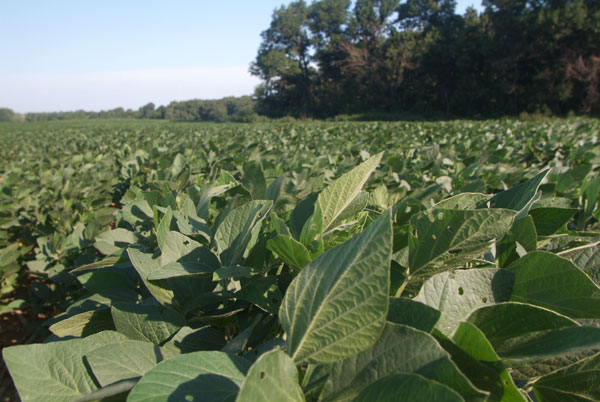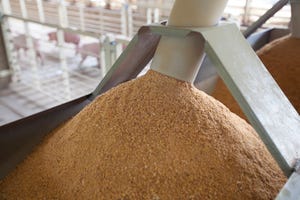University of Illinois agricultural economist Darrel Good reports U.S. soybean market fundamentals have been strong for an extended period of time.
June 25, 2012

University of Illinois agricultural economist Darrel Good reports U.S. soybean market fundamentals have been strong for an extended period of time.
“The strong fundamental factors have included record large exports in 2009-10 and 2010-11 as Chinese demand expanded, a reduction in U.S. soybean acreage in 2011, a relatively low U.S. average yield in 2011, intentions to reduce U.S. acreage again in 2012, and a very small soybean harvest in South America this year,” he says. “These strong market fundamentals continue in the form of a rapid pace of consumption and concerns about the size of the 2012 U.S. crop.”
Good reports that soybean prices began moving higher in July 2010, starting from about $9.50. July 2012 soybean futures reached a high of about $14.70 in late August 2011, declined to a low near $11.25 in mid-December 2011, and reached a high of $15.12 in early May 2012. Prices have been very choppy the past two months, but the July futures contract is now trading within about 30 cents of the early May high. November 2012 futures prices have been lower than July futures but have followed a similar pattern and are now trading at a contract high near $14.30.
“The pace of the domestic soybean crush started slowly this year,” Good says. “The National Oilseed Processors Association reported that its members crushed 7.7% fewer soybeans in the first quarter of the 2011-12 marketing year than in the same quarter the previous year. Crush during the second quarter, however, was 2.3% larger and crush during the third quarter was 7.2% larger than in the respective quarters last year. Crush during the first three quarters of the year was 0.3% larger than the crush last year. For the year, the USDA projects the crush to be 0.7% larger than during the 2010-11 marketing year.
“It now appears that the crush may exceed that projection for several reasons. First, crush was relatively small in the fourth quarter of the 2010-11 marketing year. Second, the pace of domestic soybean meal consumption has been expanding. Third, the small South American crop may support U.S. soybean meal exports above the current projection. The crush may be about 10 million bushels larger than the current projection of 1.66 billion bushels,” Good says.
At the beginning of the marketing year, the USDA projected U.S. exports at 1.415 billion bushels, Good says. The projection was reduced as the year progressed and was at 1.275 billion bushels by January 2012. “The forecast, however, increased beginning in April and now stands at 1.335 billion bushels,” he says. “Total export sales already exceed that projection, which is common, and exports will need to average about 13 million bushels per week during the last 10 weeks of the year to reach the projection. The current pace of exports is a little slower than the needed pace, but exports are still likely to reach the projected level. While the pace of exports has slowed in a typical seasonal pattern, sales for export during the 2012-13 marketing year are record large, underscoring the strength in Chinese demand. The USDA will update the projections of consumption and ending stocks for both marketing years on July 11. The estimate of June 1 stocks, to be released on June 29, will provide some confirmation about the pace of consumption and likely year-ending stocks,” Good says.
With prospects for relatively small year-ending soybean stocks, the focus is quickly turning to the prospective size of the 2012 U.S. crop. An estimate of planted and harvested acreage will be available with the USDA's June 29 Acreage report.
“With the soybean price rally that occurred this spring, it would not be surprising if acreage exceeded intentions reported in March,” Good says. “While acreage estimates will influence production prospects, the major focus will be on yield prospects.”
In the June WASDE report, the USDA projected a U.S. average yield of 43.9 bushels and 2012-13 marketing year-ending stocks at what is generally considered to be a minimum level of 140 million bushels. Good says that the trend yield for 2012 is 43.4 bushels, 1.9 bushels above the 2011 average yield.
“Continuation of stressful weather in the central and eastern growing areas along with declining crop condition ratings suggest that the 2012 yield could be below trend again in 2012,” Good says. “A shortfall in production would require that consumption during the year ahead be reduced from the current USDA projection of 3.255 billion bushels. The recent price rally is in recognition of the rationing that may be required.
“Unless weather and crop conditions improve soon, which does not appear likely, additional price strength is expected,” Good says. “Talk of the 2008 futures price peak near $16.60 has surfaced. While prices at that level are not yet justified, they are within the range that we have projected for the 'new era' of prices that began in 2007.”
Releases on other topics can be found on the ACES News Web site http://www.aces.uiuc.edu/news.
You May Also Like



